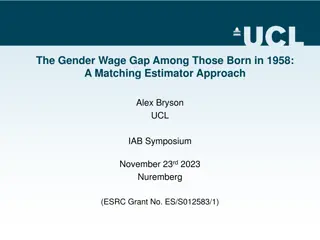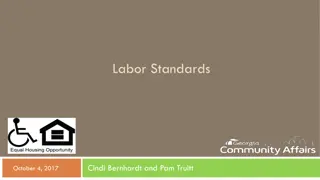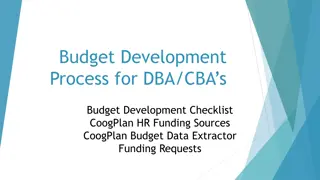DBA and DBRA: Wage Determinations and Construction Projects
This content delves into the application of multiple wage determinations under the Davis-Bacon Act (DBA) and the Related Acts (DBRA), specifically focusing on how minimum wages are determined for laborers and mechanics on construction projects. It also explains what constitutes a project of a character similar to another in terms of construction, identifies categories of construction projects, such as building, residential, highway, and heavy construction, and details the specific criteria for building and residential construction. Additionally, it discusses how to determine the height of residential buildings based on different factors.
Download Presentation

Please find below an Image/Link to download the presentation.
The content on the website is provided AS IS for your information and personal use only. It may not be sold, licensed, or shared on other websites without obtaining consent from the author.If you encounter any issues during the download, it is possible that the publisher has removed the file from their server.
You are allowed to download the files provided on this website for personal or commercial use, subject to the condition that they are used lawfully. All files are the property of their respective owners.
The content on the website is provided AS IS for your information and personal use only. It may not be sold, licensed, or shared on other websites without obtaining consent from the author.
E N D
Presentation Transcript
DBA/DBRA Application of Multiple Wage Determinations
Wage Rates - 40 USC 3142(b) The minimum wages shall be based on the wages the Secretary of Labor determines to be prevailing for the corresponding classes of laborers and mechanics employed on projects of a character similar to the contract work in the locality where the work is performed.
Project of a Character Similar A project consists of all construction necessary to complete the facility regardless of the number of contracts involved so long as all contracts awarded are closely related in purpose, time and place. The test of whether a project is of a character similar to another project refers to the nature of the project itself in a construction sense, rather than who was employed on the project or what they were paid.
Categories of Construction Projects WHD has identified four general categories of construction: Building, Residential, Highway and Heavy When the category is clear from the nature of the project itself in a construction sense, an area practice survey is not needed to categorize the project If the category is not clear, WHD will consider a variety of factors
Building Construction Construction, alteration, or repair of sheltered enclosures with walk-in access for the purpose of housing persons, machinery, equipment, or supplies. Includes all construction of such structures, the installation of utilities, and the installation of equipment both above and below grade Structures need not be habitable to be building construction Installation of machinery or equipment does not generally change the project s character from building
Residential Construction Construction, alteration, or repair of single family homes or apartment buildings of no more than four stories in height Includes items such as site work, utilities, sidewalks, etc.
Residential Construction Determining Height The lowermost floor counts as the first story when: it is primarily above ground on two or more sides it contains the main entrance to the building it is used for apartment space in a way substantially similar to the upper floors It is primarily above exterior grade on one or more sides and contains at least 50% living accommodations or related non- residential uses Stories below grade used for storage, parking, mechanical systems or equipment, etc., are considered basement stories which are not used in determining a building's height
Residential Construction Determining Height The top story, not finished for living accommodations, between the uppermost floor and the ceiling or the roof above, with floor space as large as the story below, is considered a story for purposes of determining a building's height. An attic is unfinished space located immediately below the roof. Such space is not used in determining a building's height even if used for storage purposes A half-story finished as living accommodations located wholly or partially within the roof frame with floor space at least half as large as the story below would bring the building above four stories
Highway Construction Highway projects include the construction, alteration or repair of roads, streets, highways, runways, taxiways, alleys, trails, paths, parking areas, and other similar projects
Heavy Construction The other category - projects that are not properly classified as either building, highway, or residential. Because of this catch-all nature, projects within the heavy classification may sometimes be distinguished on the basis of their particular project characteristics, and separate schedules issued, such as for dredging, water and sewer lines, dams, major bridges and flood control
Applying Multiple Wage Determinations Only arises when a project includes construction items that in and of themselves would be in a separate category of construction In determining whether a construction item would be in and of itself a separate category of construction, the nature of the construction item/project itself is considered
Applying Multiple Wage Determinations Once it has been determined that a construction item is and of itself a separate category of construction, the next point to consider is whether the cost of the work involved is substantial The cost is generally considered substantial if it exceeds 20% of the overall cost of the project or is over $1 million. If the there is a substantial amount of construction in a separate category, multiple wage determinations will be applicable.
Applying Multiple Wage Determinations If the cost is not substantial, it must then be determined whether the work is incidental in function to the overall project If the construction that in and of itself is within a separate category is not substantial in cost and is incidental in function, one wage determination applies If the construction is neither substantial in cost nor incidental in function (i.e., a small separate project included in the same contract for convenience), two wage determinations would still be issued
Multiple Wage Determinations - Example You are selecting wage determinations for a project involving the construction of four large apartment buildings, a parking lot, a children s playground, and large in-ground swimming pool. What additional information would you need to determine what wage determination(s) would be applicable to this project?
Contracting Agency Responsibilities 29 CFR 1.6(b) Contracting Agencies are responsible for insuring that only the appropriate wage determination(s) are incorporated in bid solicitations and contract specifications and for designating specifically the work to which such wage determinations will apply. Any question regarding application of wage rate schedules shall be referred to the Administrator.
Referring Questions to WHD When referring a question about wage determination applicability to WHD, contracting agencies should provide the following information: a complete and accurate description of the project; where multiple schedules may apply, the major segments of the project and a cost break-down for the construction items involved; evidence of area practice regarding wages paid on similar projects (if available); comments or other information submitted to the agency by interested parties; and the agency s recommendation as to applicability
Disclaimer This presentation is intended as general information only and does not carry the force of legal opinion. The Department of Labor is providing this information as a public service. This information and related materials are presented to give the public access to information on Department of Labor programs. You should be aware that, while we try to keep the information timely and accurate, there will often be a delay between official publications of the materials and the modification of these pages. Therefore, we make no express or implied guarantees. The Federal Register and the Code of Federal Regulations remain the official source for regulatory information published by the Department of Labor. We will make every effort to keep this information current and to correct errors brought to our attention.























